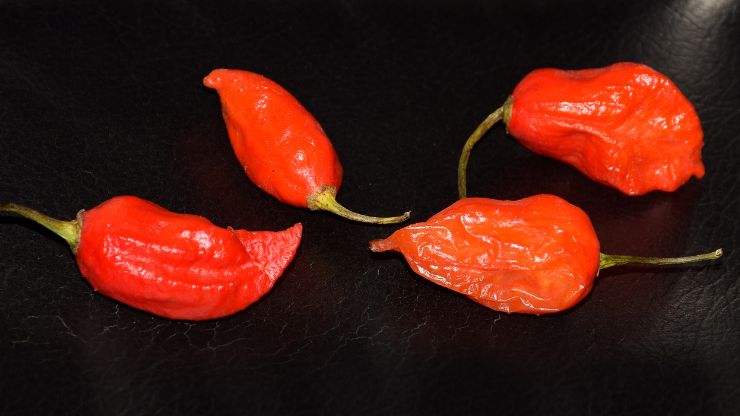Spice lovers and culinary adventurers, prepare to embark on a journey that will test the limits of your taste buds and ignite your passion for fiery flavors. The world of chili peppers is a diverse and captivating one, with each pepper offering a unique blend of heat and distinctive taste.
In this blog, we’re diving into the thrilling realm of the world’s six hottest peppers, measured on the scorching Scoville Heat Units (SHU) scale. From the blistering Carolina Reaper to the exotic Naga Viper, these peppers are not for the faint of heart.
We’ll explore the origin, appearance, and most importantly, the searing heat of each of these extraordinary peppers. So, if you’re ready to embrace the heat and add a fiery kick to your culinary creations, let’s embark on this scintillating journey through the world’s hottest peppers.
Table of Contents
ToggleSix Hottest Peppers
1. Carolina Reaper
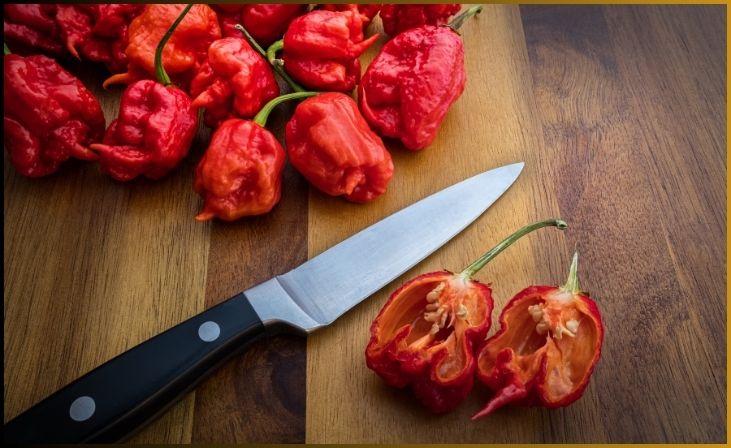
The Carolina Reaper, a name that strikes fear and excitement into the hearts of chili enthusiasts worldwide, stands as the reigning champion in the fiery world of peppers. With a scorching Scoville Heat Unit (SHU) rating that averages between 1,641,183 and a blistering 2,200,000 SHU, this pepper holds the well-deserved title of the world’s hottest.
Its distinct appearance, marked by a craggy, fiery red skin and a scorpion-like tail, is the embodiment of its searing heat. Originating in South Carolina, hence its name, this pepper is the result of a crossbreeding between a Pakistani Naga pepper and a Red Habanero, a blend that unleashed unparalleled heat.
The Carolina Reaper has become a sensation, both in the culinary world and among competitive chili-eating challengers. Its unique combination of sweet and fruity undertones, followed by an intense, mouth-numbing heat, ensures that it leaves a lasting impression on the brave souls who dare to taste it. Whether you’re looking to challenge your spice tolerance or add a fiery punch to your dishes, the Carolina Reaper is a pepper that demands respect and promises a fiery adventure like no other.
For More- Should We Worry About Food Additives?
2. Trinidad Moruga Scorpion

The Trinidad Moruga Scorpion stakes its claim as the world’s second-hottest pepper, boasting a formidable Scoville Heat Unit (SHU) rating that ranges from 1,200,000 to a searing 2,009,231 SHU. Originating from the Moruga region of Trinidad and Tobago, this pepper is a potent symbol of the country’s love for heat. Its unique appearance, characterized by a vibrant red hue and distinctive scorpion-like tail, sets it apart in the world of peppers.
What makes this pepper exceptional is the combination of its explosive heat and a surprisingly sweet and fruity flavor profile. The Trinidad Moruga Scorpion is a favorite among chili aficionados who appreciate the balance between intense heat and an intriguing taste. Whether you’re exploring the world of extreme spiciness or looking to add a fiery kick to your dishes, this pepper’s scorching embrace and tantalizing flavors make it an exciting choice for those who crave culinary adventure.
3. 7 Pot Douglah
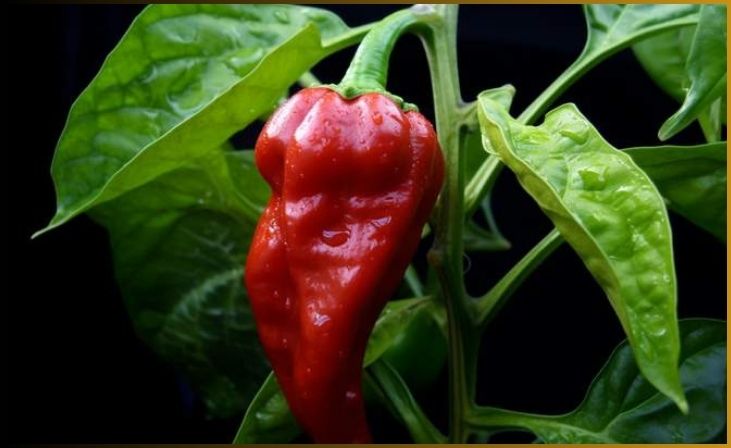
The 7 Pot Douglah, often known as the Chocolate 7 Pot, hails from the captivating culinary landscape of Trinidad and Tobago. With an impressive Scoville Heat Unit (SHU) rating ranging from 923,889 to a blistering 1,853,986 SHU, it holds its own among the world’s hottest peppers. What sets the 7 Pot Douglah apart is its deep, chocolatey brown color, a stark contrast to the fiery heat it delivers.
This pepper presents a rich and earthy flavor with nutty undertones, a combination that tantalizes the taste buds while unleashing an intense spiciness. It has become a favorite for those who appreciate super-hot peppers with a unique twist. The 7 Pot Douglah’s exceptional heat and intriguing flavor make it a fantastic choice for those who want to explore the diverse world of chili peppers and add a distinctive and fiery dimension to their culinary creations.
4. Bhut Jolokia (Ghost Pepper)
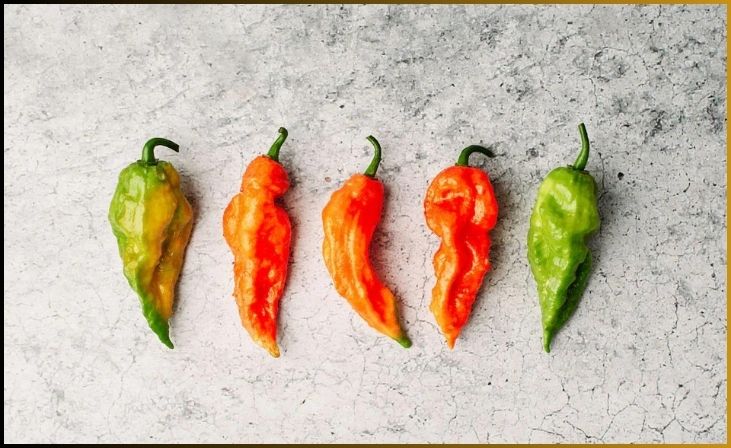
The Bhut Jolokia, famously known as the Ghost Pepper, is a legendary figure in the realm of chili peppers. Hailing from the Assam region of India, this pepper’s notoriety lies in its intense heat, making it one of the world’s hottest peppers. The Ghost Pepper boasts an astounding Scoville Heat Unit (SHU) rating that averages between 1,041,427 and an astonishing 1,641,183 SHU. Its name “Ghost Pepper” is apt, as its fiery bite can seemingly haunt your taste buds long after consumption.
Don't just scroll, subscribe!
BuzzTrail's unique web-stories are the cure for boredom you've been waiting for.
The pepper showcases a distinctive, wrinkled, and slightly bumpy appearance, usually in shades of red or orange. Its flavor profile marries a fruity sweetness with a searing heat, creating a sensory rollercoaster for those who dare to taste it. The Bhut Jolokia has garnered international fame and is a popular choice for adding scorching spice to dishes, hot sauces, and even challenges. For chili enthusiasts and the daring culinary explorer, the Ghost Pepper remains a thrilling symbol of heat and adventure.
5. Naga Viper
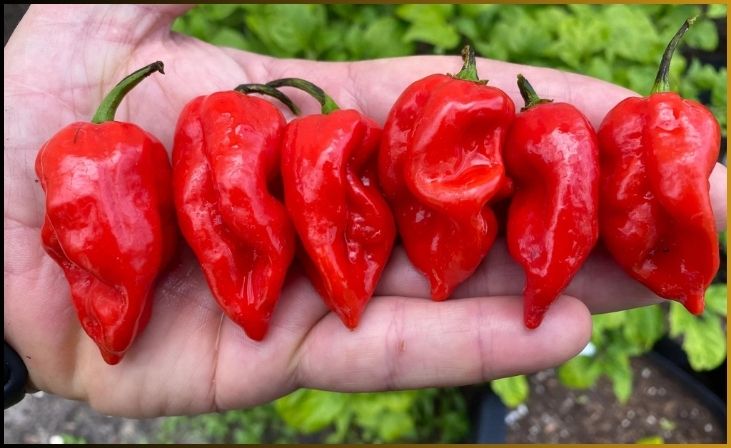
The Naga Viper emerges as a fiery contender in the world of super-hot peppers. Hailing from the United Kingdom, this pepper holds its own with a Scoville Heat Unit (SHU) rating that ranges from a searing 900,000 to a blistering 1,382,118 SHU. While it may not have the long-established chili-pepper heritage of some other contenders, the Naga Viper offers a unique and potent experience for spice enthusiasts.
The pepper’s flavor profile features a hint of citrus, adding an interesting dimension to its intense heat. The Naga Viper’s vibrant red color and elongated shape contribute to its visual appeal. Whether you’re seeking to test your spice tolerance, add a fiery kick to your dishes, or explore the world of peppers beyond traditional boundaries, the Naga Viper is a bold and exciting choice that promises an unforgettable heat-filled journey.
6. Habanero
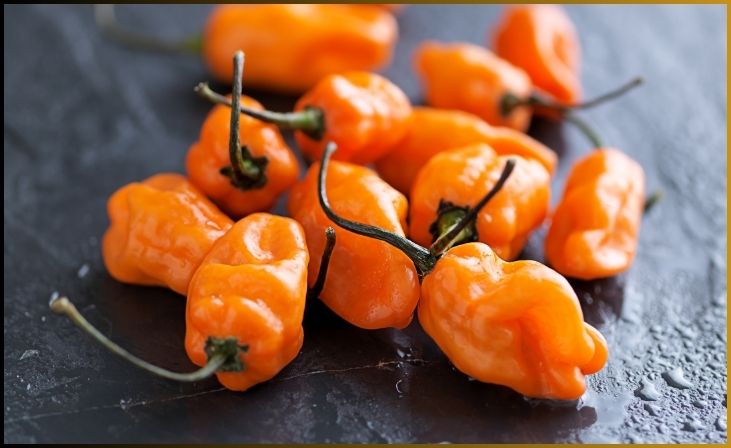
The Habanero Pepper is a beloved and fiery member of the chili pepper family known for its intense heat and vibrant flavors. Hailing from the Caribbean, Mexico, and Central America, this pepper boasts a Scoville Heat Unit (SHU) rating that typically ranges from 100,000 to 350,000 SHU, although some varieties can be even hotter. It is instantly recognizable by its lantern-like shape and a spectrum of colors, from bright orange to fiery red.
What sets the Habanero apart is its unique combination of heat and fruity, slightly citrusy flavors. While it delivers a spicy punch, it also carries a tropical sweetness that adds depth to its taste. Habanero peppers are widely used in various cuisines to add a zesty kick to salsas, hot sauces, and dishes that benefit from a fiery flavor infusion. For those who appreciate a balance between intense spiciness and a distinctive taste, the Habanero stands as a delightful choice in the world of chili peppers.
Pepper Preservation
You’ve experienced the thrill of growing or acquiring some of the world’s hottest peppers. The Carolina Reaper, Trinidad Moruga Scorpion, or Naga Viper have graced your kitchen, adding their fiery presence to your culinary adventures. But what do you do when you have more of these super-hot peppers than you can consume immediately? The answer lies in pepper preservation. Preserving these potent peppers ensures that you can enjoy their fiery goodness year-round and share them with friends and family. In this guide, we’ll explore various methods of preserving super-hot peppers, from drying and pickling to making your fiery hot sauces. So, let’s dive into the art of pepper preservation and keep the heat alive in your kitchen.
1. Drying Super-Hot Peppers
Drying is one of the oldest and most effective methods for preserving peppers. It removes the moisture, which is where many of the peppers’ spiciness resides, concentrating their heat and flavor. Here’s how to do it:
- Air Drying: Simply hang your peppers in a dry, well-ventilated area. Thread a needle and string through the stems, then hang them up. This method can take a few weeks, but the results are worth it.
- Dehydrator: If you’re looking for a quicker option, a food dehydrator is your friend. Slice the peppers and arrange them on the trays. Set the dehydrator to a low heat (around 125°F or 52°C) and let it work its magic.
Once your peppers are completely dried, store them in an airtight container. You can keep them whole or crush them into pepper flakes. Dried super-hot peppers are excellent for adding a kick to your dishes throughout the year.
2. Pickling Super-Hot Peppers
Pickling is a popular preservation method that not only maintains the heat but also infuses the peppers with a tangy, flavorful brine. To pickle super-hot peppers, follow these steps:
- Clean the Peppers: Wash and dry the peppers. Cut them into slices, rings, or leave them whole, depending on your preference.
- Create the Brine: In a saucepan, combine equal parts water and vinegar. Add a pinch of salt and sugar for flavor. Heat the mixture until it simmers, stirring until the salt and sugar dissolve.
- Pack the Peppers: Place your pepper slices or whole peppers in sterilized glass jars. Pour the hot brine over the peppers, leaving a small headspace at the top.
- Seal and Store: Seal the jars and let them cool to room temperature. Then, refrigerate them for a week before using. Your pickled super-hot peppers will be ready for consumption and can last in the fridge for several months.
3. Crafting Homemade Hot Sauces
If you’re feeling adventurous and want to create custom hot sauces that showcase your super-hot peppers, here’s how:
- Prepare the Peppers: Wear gloves while handling the super-hot peppers to avoid contact with your skin. Remove the stems and seeds, which can be incredibly spicy.
- Blend and Strain: Place the pepper flesh in a blender with a combination of vinegar, garlic, and any other flavorings you desire. Blend until smooth. Then, strain the mixture to remove any solids.
- Cook the Sauce: In a saucepan, simmer the strained liquid until it thickens to your desired consistency. Be cautious—the fumes can be potent, so good ventilation is essential.
- Bottle and Store: Pour your homemade hot sauce into sterilized bottles or jars. Seal them while the sauce is hot, and then let it cool. Homemade hot sauces can last for several months in the refrigerator.
Also Read- What is Modified Food Starch – types & Applications (2023)
Conclusion
In the realm of culinary adventures, few things match the thrill of exploring the world’s hottest peppers. From the searing Carolina Reaper to the flavorful Bhut Jolokia and everything in between, these peppers captivate our senses, challenge our taste buds, and elevate our dishes to new heights of spiciness. The journey through the world’s six hottest peppers has been an eye-opening and palate-igniting experience. Whether you’re a chili aficionado seeking the ultimate thrill or simply someone who appreciates a fiery kick in your meals, these peppers offer a world of possibilities.
FAQs
Are these peppers only for extreme chili lovers?
Are these peppers only for extreme chili lovers?
While these peppers are incredibly hot, they can be enjoyed in moderation by those who appreciate a spicy kick in their dishes. Just use them sparingly and with caution.
How can I safely handle super-hot peppers?
How can I safely handle super-hot peppers?
Always wear gloves when handling super-hot peppers, and avoid touching your face, especially your eyes. Proper ventilation is crucial when cooking with them.
What are some popular dishes that feature these peppers?
What are some popular dishes that feature these peppers?
These peppers can be used to add heat to a variety of dishes, including hot sauces, salsas, chili, and even spicy cocktails.

